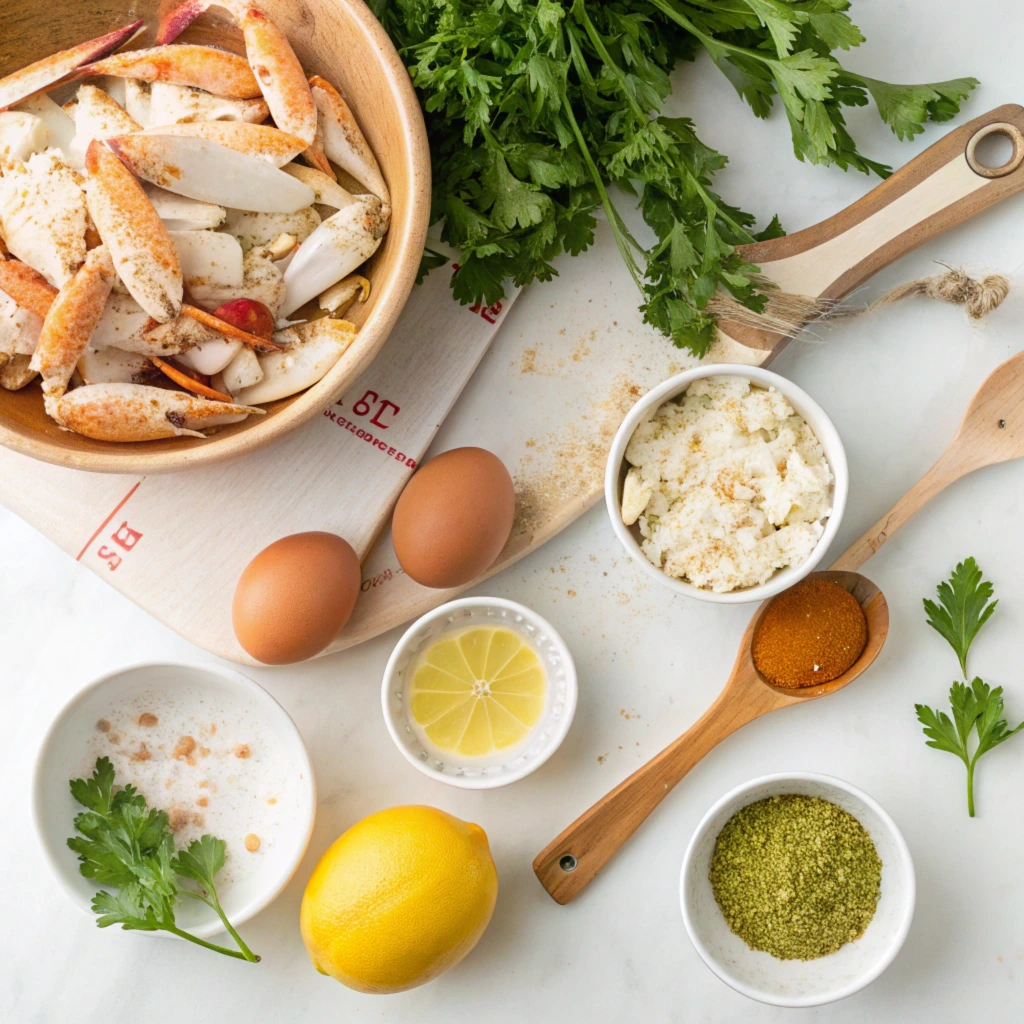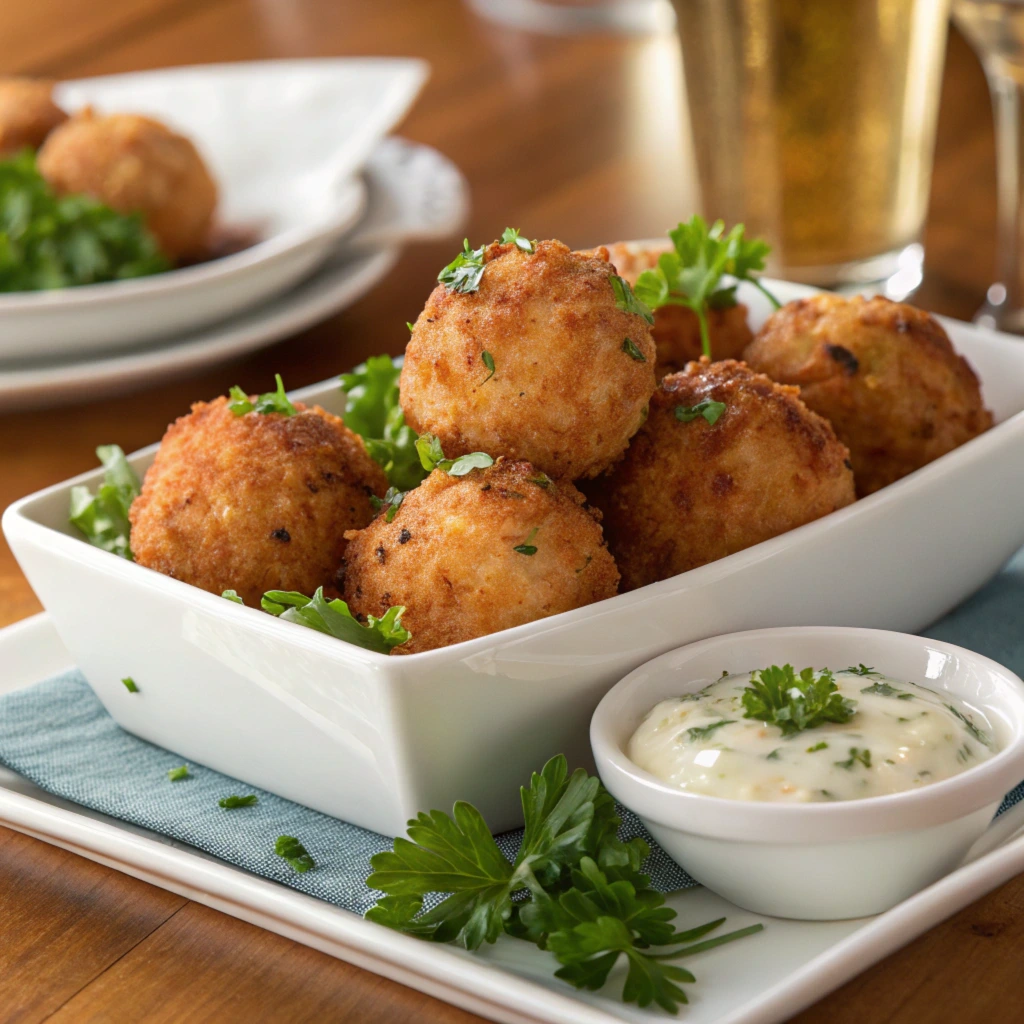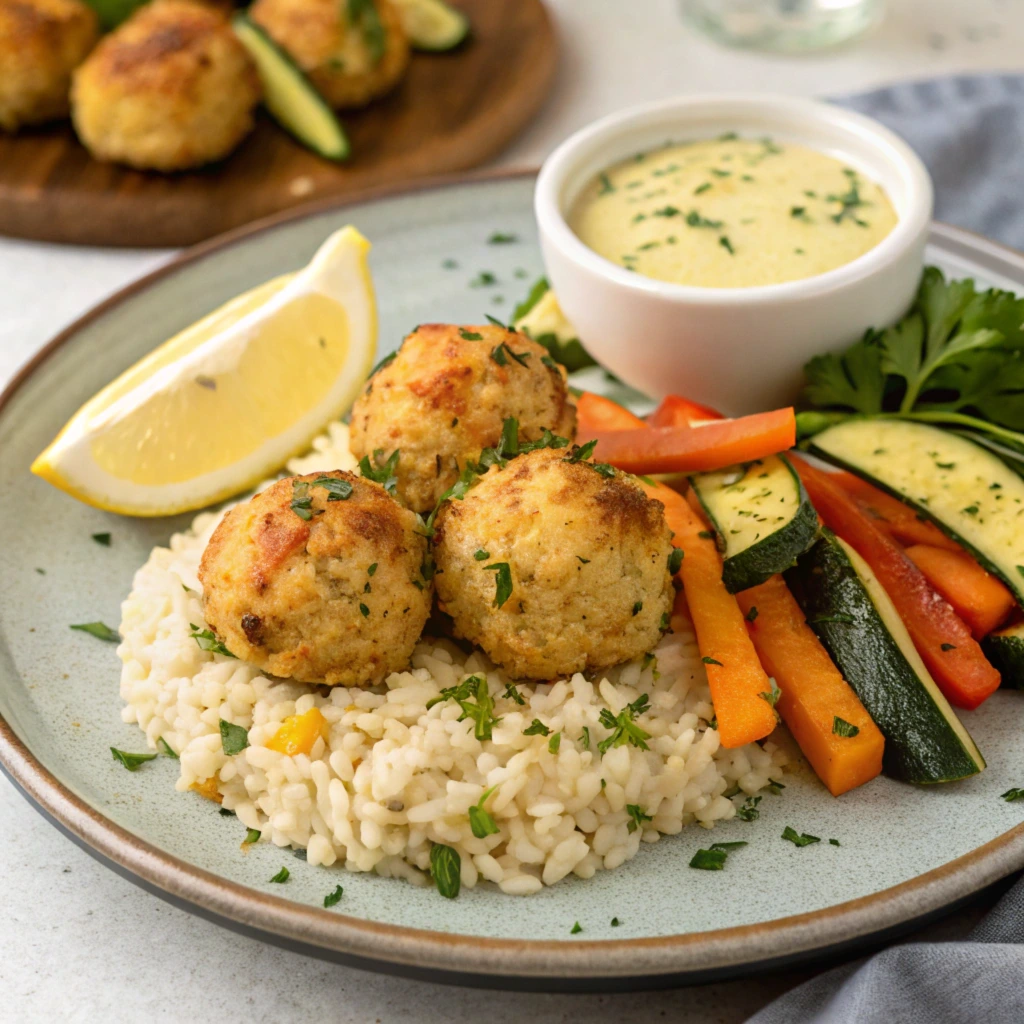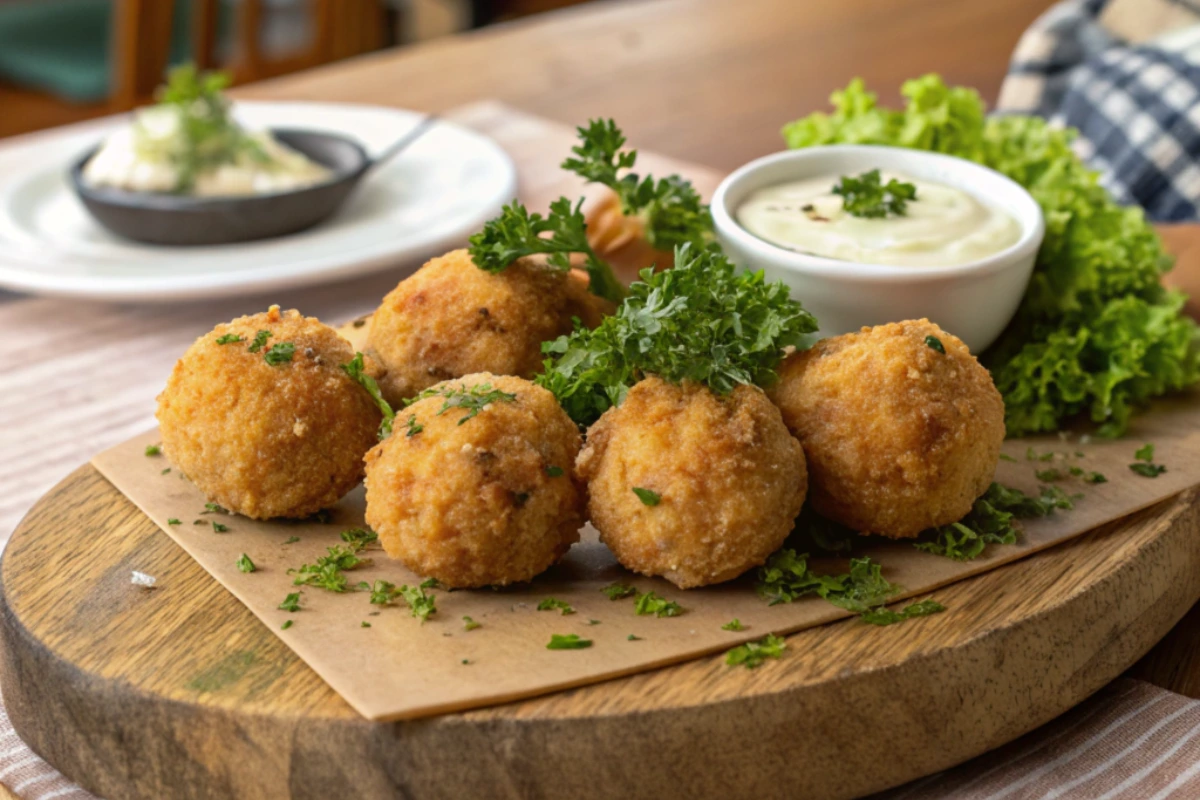Crab balls are one of those delightful seafood appetizers that effortlessly steal the show at any gathering. In this article, we’ll take you on a flavorful journey to explore what crab balls are made of, how they’re prepared, and how to serve them like a pro. From the freshest crab meat to the perfect balance of spices, each part of this guide will give you everything you need to know to master this dish.
Introduction to Crab Balls
What Are Crab Balls?
Crab balls are delectable seafood bites made with tender crab meat, infused with a blend of herbs, spices, and binding ingredients. A smaller, snackable version of the classic crab cake, they’re ideal for parties, appetizers, or a quick seafood indulgence. Known for their soft texture and rich flavor, these treats are a hit at any occasion.
Origins of Crab Balls: A Brief History
The origin of crab balls can be traced back to coastal regions, particularly the Chesapeake Bay area in Maryland, where blue crabs reign supreme. Inspired by traditional crab cakes, locals began crafting smaller, more portable versions to enjoy at festivals and events. Over time, crab balls evolved into a staple seafood dish across the United States.
Why Are Crab Balls Popular?
What makes these seafood treats so popular is their incredible versatility. Whether baked, fried, or air-fried, they can be tailored to suit a wide range of tastes and dietary needs. Their bite-sized format also makes them convenient to serve and enjoy. Pair them with tangy tartar sauce or zesty remoulade, and you have a dish guaranteed to impress any crowd!
Key Ingredients in Crab Balls

The Role of Fresh Crab Meat
Fresh crab meat is the cornerstone of any truly delicious seafood dish. Its quality plays a crucial role in determining the flavor and texture of the final product. Many recipes highlight lump or claw meat for their naturally sweet taste and delicate, tender consistency. Choosing fresh crab ensures a rich, ocean-inspired flavor that stands out. While frozen or imitation alternatives can suffice in a pinch, they often lack the depth and authenticity of fresh options.
Binders and Fillers: Eggs, Breadcrumbs, and Alternatives
To hold the crab balls together, a binding agent like eggs is essential. Breadcrumbs, often seasoned for added flavor, are the go-to filler to give the mixture some body. However, for those following low-carb diets, almond flour or crushed pork rinds make excellent substitutes. These ingredients not only help form the perfect ball shape but also add texture to the dish.
Spices and Flavorings Used in Crab Balls
The perfect blend of seasonings is essential to making these seafood bites shine. Old Bay seasoning is a must-have, offering a distinctive mix of salty, spicy, and subtly sweet notes. Garlic and parsley bring depth, while a touch of mustard adds a tangy edge. A squeeze of fresh lemon juice provides a bright, zesty finish. Striking the right balance with these flavors ensures that the crab remains the highlight of every bite.
Regional Variations in Ingredients
From the shores of Maryland’s Chesapeake Bay to the vibrant Gulf Coast, regional takes on this seafood dish celebrate unique local flavors. Maryland-style versions typically emphasize Old Bay seasoning for a classic, savory profile. In contrast, Southern adaptations might include a kick of cayenne pepper for added heat. These regional differences underscore just how versatile and adaptable this beloved recipe can be.
Ingredients, Preparation Time, and Step-by-Step Process

Ingredients for Crab Balls
To make a batch of flavorful crab ball, you’ll need the following:
- 1 pound of lump crab meat (fresh or pasteurized)
- 1 large egg (for binding)
- 1/2 cup of seasoned breadcrumbs (or gluten-free alternative)
- 2 tablespoons mayonnaise
- 1 teaspoon Dijon mustard
- 1 teaspoon Old Bay seasoning
- 1/4 cup chopped fresh parsley
- 1 clove of garlic, minced
- Juice of half a lemon
- Salt and pepper to taste
- Oil for frying (if deep frying)
Preparation Time
- Prep time: 20 minutes
- Cooking time: 10–15 minutes
- Total time: 30–35 minutes
Step-by-Step Process
1. Prepping the Crab Meat
Start by gently picking through the lump crab meat to remove any shells or cartilage. Keep the meat in large chunks to ensure a rich texture in your crab balls.
2. Mixing the Ingredients
In a large bowl, combine the crab meat, breadcrumbs, egg, mayonnaise, Dijon mustard, Old Bay seasoning, parsley, garlic, and lemon juice. Season with salt and pepper. Mix carefully to avoid breaking up the crab meat too much. The mixture should be moist but firm enough to hold its shape.
3. Shaping the Crab Balls
Using your hands or a small scoop, form the mixture into evenly sized balls, roughly 1–1.5 inches in diameter. Place them on a baking sheet lined with parchment paper.
4. Choosing a Cooking Method
- Baking: Preheat your oven to 375°F (190°C). Place the prepared seafood bites on a greased baking sheet, ensuring they are evenly spaced. Bake for 12–15 minutes, or until they develop a beautiful golden-brown color and are fully cooked through.
- Frying: Heat oil in a deep skillet over medium heat. Fry the crab balls in batches for 3–4 minutes on each side, until crispy and golden. Drain on paper towels.
- Air Frying: Preheat your air fryer to 375°F (190°C). Spray the crab balls lightly with cooking spray and air fry for 10–12 minutes, flipping halfway through.
5. Serve and Enjoy
Serve these tasty seafood bites warm alongside your favorite dipping sauce, like tartar sauce or remoulade. For a polished presentation, garnish with a sprinkle of fresh parsley and a wedge of lemon to add a touch of elegance.
Serving Suggestions and Accompaniments
Popular Dipping Sauces for Crab Balls
No crab ball dish is complete without a dipping sauce! A creamy tartar sauce is a classic choice, balancing the savory richness of the crab with a tangy kick. Spicy remoulade, infused with Cajun spices, adds an exciting depth of flavor. For a lighter option, try a yogurt-based dill sauce, which pairs beautifully with the fresh seafood taste.
Sides That Pair Well with Crab Balls
These seafood treats truly stand out when paired with the right sides. A crisp garden salad adds a refreshing element, while roasted vegetables offer a hearty, comforting touch. For a more indulgent option, try serving them alongside garlic butter rice or creamy cheesy grits. These accompaniments elevate the meal, creating a flavorful and satisfying dining experience.
Presentation Tips for Crab Balls
To wow your guests, presentation matters! Arrange crab balls on a platter lined with fresh greens, and add a wedge of lemon for a pop of color. Garnish with chopped parsley to give the dish a fresh, vibrant look. If you’re serving a dipping sauce, consider placing it in a small bowl in the center of the platter for easy access.
For more seafood inspiration, explore this perfect crab balls recipe on Library Recipes.

Nutritional Information and Dietary Variations
Caloric Content and Macronutrient Breakdown
Crab balls are a seafood lover’s dream, but they’re also surprisingly nutritious. Made with fresh crab meat, they’re high in protein and low in calories. However, the nutritional content can vary depending on the cooking method. Baking is the healthiest choice, while frying adds a bit more fat and calories. On average, a serving of crab balls contains approximately 150–200 calories.
Gluten-Free and Dairy-Free Adaptations
If you’re accommodating specific dietary needs, crab balls can easily be adapted. For a gluten-free version, swap out regular breadcrumbs for almond flour or gluten-free panko. To make them dairy-free, avoid adding any cheese-based ingredients or creamy binders. With these adjustments, you can still enjoy this dish without compromising on taste.
Vegan Alternatives and Mock Crab Balls
Following a vegan diet but craving seafood-inspired flavors? Mock versions of this dish are a fantastic alternative! Crafted with ingredients like jackfruit, chickpeas, or hearts of palm, these substitutes closely mimic the texture and taste of traditional crab meat. Seasoned with Old Bay and seaweed flakes, they deliver an authentic seafood-like experience. Perfect for plant-based eaters, these creative options allow you to enjoy the essence of this classic appetizer without compromising your dietary preferences.
Frequently Asked Questions (FAQs)
What Kind of Crab Meat Is Best for Crab Balls?
The type of crab meat you use can greatly affect the flavor and texture of your crab balls. Lump crab meat is a favorite choice for its sweet taste and large, flaky chunks. Claw meat is another excellent option, offering a slightly stronger, richer flavor. While fresh crab meat is ideal, canned or pasteurized crab meat works well if fresh isn’t available. Always ensure the crab meat is free of shells and cartilage before mixing.
Can Crab Balls Be Made Ahead of Time?
Absolutely! Preparing crab balls ahead of time is a smart way to save time, especially if you’re hosting a party or planning a busy weeknight meal. You can make the crab mixture up to 24 hours in advance and store it in the refrigerator, tightly covered to maintain freshness. When you’re ready to cook, simply shape the mixture into balls and proceed with your preferred cooking method.
Cooked crab balls are also great for leftovers. Store them in an airtight container in the refrigerator, where they’ll stay fresh for 3–4 days. If you want to extend their shelf life, freezing is a fantastic option. Place the cooled crab balls on a baking sheet, freeze until solid, and then transfer them to a freezer-safe bag or container. They’ll keep for up to three months. To reheat, pop them into the oven or air fryer to revive their crispy exterior and warm, flavorful interior.
How Should Crab Balls Be Stored?
To keep your crab balls as delicious as when they were first made, proper storage is key. If they’re freshly cooked, allow them to cool completely before storing to prevent moisture buildup, which can make them soggy. Place them in an airtight container to lock in freshness. For short-term storage, refrigerate them for up to four days.
If you plan to keep them longer, freezing is the way to go. Flash-freeze the crab balls on a baking tray so they don’t stick together, then transfer them to a freezer bag. When you’re ready to enjoy, reheat them in an oven or air fryer rather than the microwave to restore their crispy texture and ensure they’re evenly warmed.
What Are Some Common Mistakes to Avoid?
Making crab balls isn’t complicated, but a few missteps can affect the final result. One frequent mistake is overmixing the ingredients. Overmixing can break down the delicate crab meat, leading to dense and less flavorful crab balls. Instead, mix gently to preserve the texture of the crab.
Another error is relying too heavily on fillers, such as breadcrumbs or other binding agents. While they’re necessary to hold the mixture together, overdoing it can overshadow the crab meat’s natural sweetness and turn the crab balls into heavy, doughy bites.
Finally, when frying, it’s crucial not to overcrowd the pan. Crowding lowers the oil temperature, causing uneven cooking and a greasy result. Cook the crab balls in small batches to achieve that signature golden, crispy exterior. Taking these precautions will help ensure your crab balls turn out perfectly every time.
Conclusion and Final Thoughts on Crab Balls
Why Everyone Should Make Crab Balls
Crab balls are more than just an appetizer, they’re a bite-sized celebration of the ocean’s finest flavors. Whether you’re hosting a formal dinner party or preparing a casual snack for friends, these versatile treats never fail to impress. Their crisp exterior and tender, flavorful interior make them a crowd-pleaser for all ages. Plus, they’re easy to customize to suit your taste or dietary needs, making them a dish that truly caters to everyone.
A Versatile Dish for Any Occasion
One of the best things about crab balls is their adaptability. You can serve them at elegant events with gourmet sauces or as a simple comfort food for family gatherings. They also pair well with a variety of sides, from fresh salads to buttery rice. Whether you’re frying, baking, or air frying, this recipe remains quick, fun, and rewarding to prepare.
Encouragement to Get Creative
Cooking is an art, and crab balls are the perfect canvas for creativity. Experiment with new seasonings, add spicy elements for a kick, or try vegan versions to make them plant-based. Each variation is a chance to discover something uniquely yours. With a few basic ingredients and some simple techniques, you can elevate this classic dish into a signature recipe that’s bound to become a favorite.
So, grab your ingredients, and let your culinary adventure with crab balls begin!

